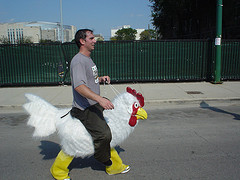 I recently participated in a runners clinic, where I gave out information about runners stretches, foam rolling massage techniques, and training schedules for running a 5K and half marathon. Questions about injury prevention usually led down the same path- run less and cross-train. There are those out there that believe the best way to train for runs is to run… and JUST run. In terms of injury prevention and performance, runners should be cross-training. Treat your exercise like your investments and diversify. Running is a great endurance sport, but it does require flexibility, strength, and stability, particularly of the hips and core. If you don’t have sufficient strength in these areas, your form can suffer, resulting in overuse injuries and an inefficient running gait that makes you slower. Weak core and hip muscles result in more side to side motion, rather than linear motion, which wastes energy.
I recently participated in a runners clinic, where I gave out information about runners stretches, foam rolling massage techniques, and training schedules for running a 5K and half marathon. Questions about injury prevention usually led down the same path- run less and cross-train. There are those out there that believe the best way to train for runs is to run… and JUST run. In terms of injury prevention and performance, runners should be cross-training. Treat your exercise like your investments and diversify. Running is a great endurance sport, but it does require flexibility, strength, and stability, particularly of the hips and core. If you don’t have sufficient strength in these areas, your form can suffer, resulting in overuse injuries and an inefficient running gait that makes you slower. Weak core and hip muscles result in more side to side motion, rather than linear motion, which wastes energy.
Check out this video to see how weakness in the pelvis can affect form.
To make your runs more efficient and prevent an injury, participate in other activities and exercises to strengthen, stretch, and stabilize key areas of the body. It’s important to remain flexible in the hips and lower legs to prevent a host of running conditions from plantar fasciitis to iliotibial band syndrome. To maintain good linear motion and prevent fatigue, strength train, particularly at the hip and core, but also postural muscles to maintain a neutral and straight spinal position.
Diversifying Activities:
1. Pilates: It builds hip and core strength,which is important to maintain good running form, in addition to working on your posture
2. Yoga: Don’t like to stretch? Try yoga. You’re stretching multiple muscle groups in a session and it’s more fun that holding a quad stretch for 30 seconds. Additionally yoga can benefit your body by reducing stress and improving balance.
3. Strength Training: Hard to run up that hill? You need to work on your strength. Use weights and get stronger. Also work on the muscles in your back to maintain a good posture while running.
4. Bike: Looking to work on your endurance in other ways? Try another endurance sport that requires good leg strength- cycling. Try some interval training for variety.
So, yes, you may have to take days out of the week to do exercise that does not involve running. If you’re unsure of what to do, a physical therapist can evaluate your running mechanics and look at your strength and flexibility to make a customized exercise program to fit your needs. In the long term, running less will make you a better runner. Diversifying your activities will improve your form, making you more efficient and faster, and keep your body more balanced and free of musculoskeletal injuries.
If you want a yoga and pilates breakdown, visit PTJess’ blog here for yoga and here for pilates
More on the chicken guy whoa. Would like to know the end of the story and how he finished that marathon…










April 26, 2010
Running, Sports Medicine